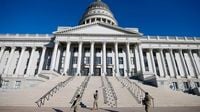Two landmark court rulings—one in Alabama, one in Utah—are shaking up the political landscape and reigniting fierce debates over voting rights and partisan gerrymandering. On August 25, 2025, federal and state judges in both states delivered decisions that could reshape how legislative and congressional districts are drawn, with far-reaching implications for minority representation and the balance of power in the U.S. House of Representatives.
In Montgomery, Alabama, U.S. District Judge Anna M. Manasco, appointed by former President Donald Trump, ruled that the state’s Senate map must be redrawn to include a majority-Black, or nearly majority-Black, district in the Montgomery area. According to AL.com, Judge Manasco found that the current map gives Black voters a lesser chance to elect candidates of their choice compared to other voters, violating Section 2 of the Voting Rights Act. “As the Legislature considers such plans, it should be mindful of the practical reality, based on the ample evidence of intensely racially polarized voting adduced during the trial, that any remedial plan will need to include an additional district in the Montgomery area in which Black voters either comprise a voting-age majority or something quite close to it,” she wrote in her decision.
The ruling comes at a pivotal moment. All 140 seats in the Alabama Legislature—including 35 Senate seats—will be on the ballot in 2026. Montgomery’s District 25 is currently represented by Sen. Will Barfoot, a white Republican, while District 26 is held by Sen. Kirk Hatcher, a Black Democrat. Civil rights groups, including the NAACP, the American Civil Liberties Union, the Legal Defense Fund, and the Southern Poverty Law Center, had filed suit to block the use of the current map for upcoming elections.
Benard Simelton, president of the Alabama State Conference of the NAACP, celebrated the decision, stating, “This decision proves that when we challenge injustice, we can make progress.” Deuel Ross, director of litigation at the Legal Defense Fund, echoed this sentiment, calling the ruling “a hard-fought victory for Black voters in Montgomery who deserve fair representation in the Alabama Senate.” However, Ross also noted that the fight is not over, as the court did not find violations in the Huntsville portion of the map. “While we welcome this win, leaving the Huntsville district in place illustrates that voters must continue to fight for their voices to be heard,” Ross told AL.com.
Not everyone is pleased. Alabama State Sen. Steve Livingston, the Senate’s majority leader, expressed disappointment with the Montgomery ruling, stating, as reported by WCVB, “We will determine next steps after a thorough review of the opinion in the coming days.” Still, he and other Republican leaders were satisfied with the court’s decision to leave the Huntsville district unchanged. Alabama’s primary election is set for May 19, 2026, adding urgency to the redistricting process.
This ruling is the latest chapter in a years-long battle over Black voting power in Alabama. In 2023, after a U.S. Supreme Court decision, the GOP-controlled legislature drew new maps that still left only one majority-Black district out of seven in a state with a 27% Black population. Two weeks prior to Judge Manasco’s ruling, a federal court ordered Alabama to continue using a court-drawn Congressional district map until 2030, highlighting the ongoing tug-of-war between lawmakers and the courts over fair representation.
Meanwhile, in Utah, a state-level drama is unfolding over congressional redistricting. District Court Judge Dianna Gibson ruled that Utah’s Republican-controlled Legislature must rapidly redraw the state’s congressional boundaries. The judge found that lawmakers had circumvented voter-established safeguards designed to prevent partisan gerrymandering, particularly by weakening and ignoring an independent redistricting commission created by a 2018 ballot initiative.
“The nature of the violation lies in the Legislature’s refusal to respect the people’s exercise of their constitutional lawmaking power and to honor the people’s right to reform their government,” Judge Gibson wrote in her ruling, as reported by the Associated Press. The current map, adopted in 2021, divides Salt Lake County—Utah’s population center and a Democratic stronghold—among four congressional districts, all of which have since elected Republicans by wide margins.
Lawmakers now face a tight deadline: new maps must be drawn by September 24, 2025, before candidate filing begins in early January for the 2026 midterm elections. Voting rights groups who challenged the map can submit alternate proposals to the court. However, Republican officials are expected to appeal, potentially delaying the adoption of new maps until 2028. This uncertainty comes as Republicans prepare to defend their slim majority in the U.S. House, with Democrats needing to net just three seats next year to retake control of the chamber.
David Reymann, attorney for the voting rights advocates, called the ruling a “watershed moment” for Utah voters. “The Legislature in this state is not king,” Reymann said, underscoring the tension between lawmakers and the electorate. Democratic leaders nationally hailed the decision as a victory for democracy, while Utah’s Republican Governor Spencer Cox voiced disagreement but respect for the judiciary. GOP legislative leaders, Senate President Stuart Adams and House Speaker Mike Schultz, expressed disappointment and are considering their next steps. State GOP Chairman Robert Axson dismissed the ruling as “judicial activism.”
The roots of Utah’s redistricting dispute stretch back to 2018, when voters narrowly approved a ballot initiative to create an independent commission tasked with drawing legislative and congressional boundaries. In 2020, the Legislature repealed the initiative and replaced it with an advisory board, which lawmakers could ignore. The following year, they disregarded the commission’s map proposal and drew their own, splitting Salt Lake County among four reliably Republican districts. Voting rights advocates sued, arguing the Legislature’s actions constituted partisan gerrymandering and violated voter rights. The Utah Supreme Court ruled that the Legislature cannot change laws approved through ballot initiatives except to reinforce them or advance a compelling government interest, sending the case back to Judge Gibson for a final decision.
Utah’s saga is part of a broader national struggle over redistricting. After the 2020 census, several states saw similar battles. Missouri’s Republican-led Legislature repealed key provisions of its own anti-gerrymandering initiative, while independent commissions in Colorado and Michigan remained intact. The U.S. Supreme Court, in a 2019 decision, declared that claims of partisan gerrymandering for congressional and legislative districts are outside the purview of federal courts, leaving the matter to states. This has emboldened lawmakers in both parties to test the limits of their power—sometimes at odds with the will of voters.
As the 2026 elections approach, the outcomes of these legal battles in Alabama and Utah could influence not just state politics, but the very composition of Congress. For now, the message from the courts is clear: the fight over fair representation is far from finished, and the voices of voters—whether in Montgomery or Salt Lake City—are not so easily silenced.




